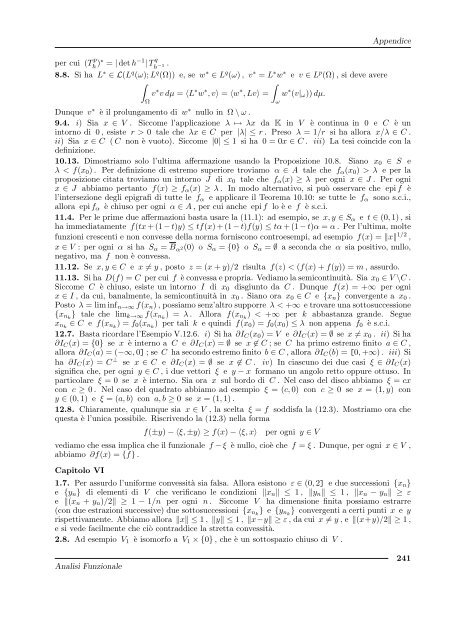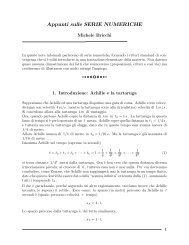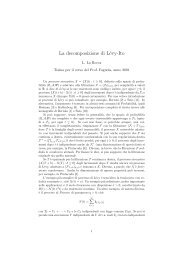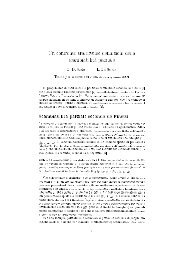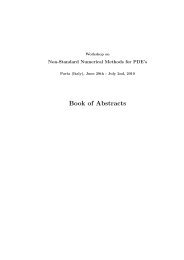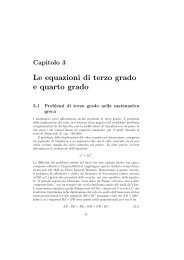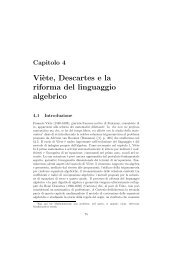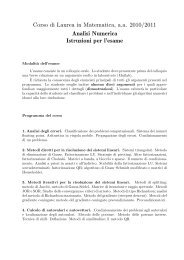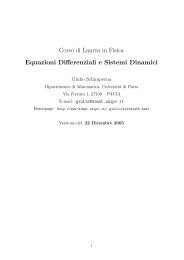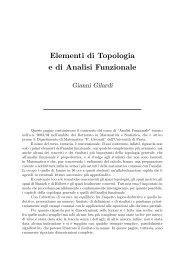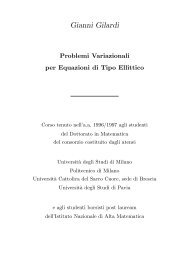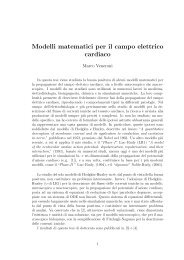G. Gilardi, Analisi Funzionale - Dipartimento di Matematica
G. Gilardi, Analisi Funzionale - Dipartimento di Matematica
G. Gilardi, Analisi Funzionale - Dipartimento di Matematica
You also want an ePaper? Increase the reach of your titles
YUMPU automatically turns print PDFs into web optimized ePapers that Google loves.
per cui (T p<br />
h )∗ = | det h−1 | T q<br />
h−1 .<br />
8.8. Si ha L∗ ∈ L(Lq (ω); Lq (Ω)) e, se w∗ ∈ Lq (ω) , v∗ = L∗w∗ e v ∈ Lp (Ω) , si deve avere<br />
�<br />
v<br />
Ω<br />
∗ v dµ = 〈L ∗ w ∗ , v〉 = 〈w ∗ , Lv〉 =<br />
�<br />
ω<br />
w ∗ (v|ω)) dµ.<br />
Appen<strong>di</strong>ce<br />
Dunque v∗ è il prolungamento <strong>di</strong> w∗ nullo in Ω \ ω .<br />
9.4. i) Sia x ∈ V . Siccome l’applicazione λ ↦→ λx da K in V è continua in 0 e C è un<br />
intorno <strong>di</strong> 0 , esiste r > 0 tale che λx ∈ C per |λ| ≤ r . Preso λ = 1/r si ha allora x/λ ∈ C .<br />
ii) Sia x ∈ C ( C non è vuoto). Siccome |0| ≤ 1 si ha 0 = 0x ∈ C . iii) La tesi coincide con la<br />
definizione.<br />
10.13. Dimostriamo solo l’ultima affermazione usando la Proposizione 10.8. Siano x0 ∈ S e<br />
λ < f(x0) . Per definizione <strong>di</strong> estremo superiore troviamo α ∈ A tale che fα(x0) > λ e per la<br />
proposizione citata troviamo un intorno J <strong>di</strong> x0 tale che fα(x) ≥ λ per ogni x ∈ J . Per ogni<br />
x ∈ J abbiamo pertanto f(x) ≥ fα(x) ≥ λ . In modo alternativo, si può osservare che epi f è<br />
l’intersezione degli epigrafi <strong>di</strong> tutte le fα e applicare il Teorema 10.10: se tutte le fα sono s.c.i.,<br />
allora epi fα è chiuso per ogni α ∈ A , per cui anche epi f lo è e f è s.c.i.<br />
11.4. Per le prime due affermazioni basta usare la (11.1): ad esempio, se x, y ∈ Sα e t ∈ (0, 1) , si<br />
ha imme<strong>di</strong>atamente f(tx + (1 − t)y) ≤ tf(x) + (1 − t)f(y) ≤ tα + (1 − t)α = α . Per l’ultima, molte<br />
funzioni crescenti e non convesse della norma forniscono controesempi, ad esempio f(x) = �x�1/2 ,<br />
x ∈ V : per ogni α si ha Sα = Bα2(0) o Sα = {0} o Sα = ∅ a seconda che α sia positivo, nullo,<br />
negativo, ma f non è convessa.<br />
11.12. Se x, y ∈ C e x �= y , posto z = (x + y)/2 risulta f(z) < (f(x) + f(y)) = m , assurdo.<br />
11.13. Si ha D(f) = C per cui f è convessa e propria. Ve<strong>di</strong>amo la semicontinuità. Sia x0 ∈ V \C .<br />
Siccome C è chiuso, esiste un intorno I <strong>di</strong> x0 <strong>di</strong>sgiunto da C . Dunque f(x) = +∞ per ogni<br />
x ∈ I , da cui, banalmente, la semicontinuità in x0 . Siano ora x0 ∈ C e {xn} convergente a x0 .<br />
Posto λ = lim infn→∞ f(xn) , possiamo senz’altro supporre λ < +∞ e trovare una sottosuccessione<br />
{xnk } tale che limk→∞ f(xnk ) = λ . Allora f(xnk ) < +∞ per k abbastanza grande. Segue<br />
xnk ∈ C e f(xnk ) = f0(xnk ) per tali k e quin<strong>di</strong> f(x0) = f0(x0) ≤ λ non appena f0 è s.c.i.<br />
12.7. Basta ricordare l’Esempio V.12.6. i) Si ha ∂IC(x0) = V e ∂IC(x) = ∅ se x �= x0 . ii) Si ha<br />
∂IC(x) = {0} se x è interno a C e ∂IC(x) = ∅ se x �∈ C ; se C ha primo estremo finito a ∈ C ,<br />
allora ∂IC(a) = (−∞, 0] ; se C ha secondo estremo finito b ∈ C , allora ∂IC(b) = [0, +∞) . iii) Si<br />
ha ∂IC(x) = C⊥ se x ∈ C e ∂IC(x) = ∅ se x �∈ C . iv) In ciascuno dei due casi ξ ∈ ∂IC(x)<br />
significa che, per ogni y ∈ C , i due vettori ξ e y − x formano un angolo retto oppure ottuso. In<br />
particolare ξ = 0 se x è interno. Sia ora x sul bordo <strong>di</strong> C . Nel caso del <strong>di</strong>sco abbiamo ξ = cx<br />
con c ≥ 0 . Nel caso del quadrato abbiamo ad esempio ξ = (c, 0) con c ≥ 0 se x = (1, y) con<br />
y ∈ (0, 1) e ξ = (a, b) con a, b ≥ 0 se x = (1, 1) .<br />
12.8. Chiaramente, qualunque sia x ∈ V , la scelta ξ = f sod<strong>di</strong>sfa la (12.3). Mostriamo ora che<br />
questa è l’unica possibile. Riscrivendo la (12.3) nella forma<br />
f(±y) − 〈ξ, ±y〉 ≥ f(x) − 〈ξ, x〉 per ogni y ∈ V<br />
ve<strong>di</strong>amo che essa implica che il funzionale f − ξ è nullo, cioè che f = ξ . Dunque, per ogni x ∈ V ,<br />
abbiamo ∂f(x) = {f} .<br />
Capitolo VI<br />
1.7. Per assurdo l’uniforme convessità sia falsa. Allora esistono ε ∈ (0, 2] e due successioni {xn}<br />
e {yn} <strong>di</strong> elementi <strong>di</strong> V che verificano le con<strong>di</strong>zioni �xn� ≤ 1 , �yn� ≤ 1 , �xn − yn� ≥ ε<br />
e �(xn + yn)/2� ≥ 1 − 1/n per ogni n . Siccome V ha <strong>di</strong>mensione finita possiamo estrarre<br />
(con due estrazioni successive) due sottosuccessioni {xnk } e {ynk } convergenti a certi punti x e y<br />
rispettivamente. Abbiamo allora �x� ≤ 1 , �y� ≤ 1 , �x−y� ≥ ε , da cui x �= y , e �(x+y)/2� ≥ 1 ,<br />
e si vede facilmente che ciò contrad<strong>di</strong>ce la stretta convessità.<br />
2.8. Ad esempio V1 è isomorfo a V1 × {0} , che è un sottospazio chiuso <strong>di</strong> V .<br />
<strong>Analisi</strong> <strong>Funzionale</strong><br />
241


